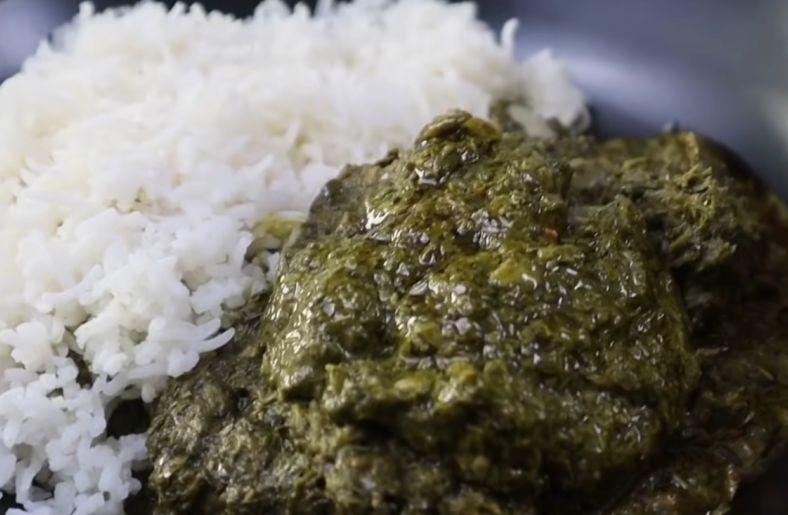Cassava leaves stew brings bold flavor and rich tradition to the table, blending tender greens with aromatic spices, palm oil, and protein for a deeply satisfying African-inspired meal.
Cassava leaves stew is a popular dish in parts of West and Central Africa, especially in Liberia, Sierra Leone, and the Democratic Republic of Congo.
Unlike the soup version, which tends to be lighter and sometimes broth-based, the stew is thicker and more concentrated, using less liquid and bolder ingredients.
It’s usually made with chopped cassava leaves, meat, fish, chili, onions, palm oil, and sometimes ground peanuts for extra flavor.
If you know cassava as a root vegetable, the leaves come from the same plant.
They’re not eaten raw; boiling them well removes toxins and prepares them for cooking. Most people serve the stew with rice, fufu, or boiled plantains.
This post focuses on how to make cassava leaves stew at home.
For more about cassava or how to prepare the leaves, check out the related posts on this site.
Table of Contents
- What is Cassava Leaves Stew?
- Traditional Ingredients Used for Cassava Leaves Stew
- How to Make Cassava Leaves Stew (Step-by-step)
- Serving Suggestions
- Cassava Leaf Stew vs Cassava Leaves Soup: What Sets Them Apart
- Nutritional Value of Cassava Leaves Stew: What You’re Eating
- Common Variations by Region: Cassava Leaves Stew Around Africa
- Frequently Asked Questions
- Conclusion
What is Cassava Leaves Stew?
Cassava leaves stew is a traditional dish made by cooking finely pounded or blended cassava leaves with palm oil, chili, onions, and seasonings.
Proteins such as meat, fish, or smoked ingredients are often added to deepen the flavor.
The result is a thick, hearty stew enjoyed in many West and Central African homes.
It is commonly served with rice, fufu, or plantains and is known for its earthy taste and rich, satisfying texture.
Traditional Ingredients Used for Cassava Leaves Stew
Cassava leaves stew is a dish you can make your own, but it starts with some key ingredients found in many kitchens across West and Central Africa.
Cassava Leaves: The Base of the Stew
You’ll need the leaves of cassava to begin. These can be fresh or frozen, depending on what’s available near you.
Fresh leaves are usually pounded or blended before cooking. Frozen leaves are pre-processed and ready to use.
Cassava leaves are packed with nutrients like iron, fiber, and vitamins. They bring an earthy flavor that defines the stew.
Once boiled properly, they form the thick base of your meal.
Palm Oil: Rich Flavor and Color
Palm oil gives your stew its bold color and deep taste. It also helps blend the ingredients.
You’ll heat it before adding other ingredients like onions and chili.
Palm oil not only adds richness but also carries the traditional taste many expect in cassava-based dishes.
If you’re following a specific diet, you can adjust the amount used, but it’s the oil that makes the dish complete in many homes.
Protein: Meat or Fish for Extra Depth
Add meat, fish, or both. Goat meat, beef, and smoked fish are common choices. You can use what you have or prefer.
Each adds its flavor and texture. Smoked fish brings a deep, savory edge. Meat gives a hearty bite.
If you’re a vegetarian, you can skip these and still enjoy a flavorful stew by using broth and extra spices.
Seasoning: Flavor That Stands Out
Your stew gets its kick from seasoning. Start with chopped onions, garlic, and fresh chili.
You can add spice blends like ground pepper or bouillon. These build a bold base and help balance the taste of the leaves.
Season to your taste. Some regions like it hot. Others go mild. What matters is getting a flavor that feels right to you.
Groundnuts or Egusi: Optional but Flavorful
Some recipes call for crushed groundnuts or melon seeds (egusi). These thicken the stew and bring a nutty taste.
If you want a richer texture or added protein, this is a good option. You can roast and grind your own or use store-bought paste.
These add-ins are common in certain areas and can make your version feel more rooted in regional cooking.
Related Posts
- Different Cassava Leaves Recipes
- How to Properly Cook Cassava Leaves
- How Cassava Leaves Benefit Health
- Cassava Leaves Nutritional Facts
- Cassava Leaves Benefits
- Cassava Leaves and Fufu: The Perfect Pairing
- White Rice and Cassava Leaves Combo
How to Make Cassava Leaves Stew (Step-by-step)
If you’ve got cassava leaves and want to turn them into a hearty meal, this simple guide walks you through it from start to finish.
Wash and Chop the Cassava Leaves
Start by cleaning the cassava leaves. Rinse them thoroughly in clean water to remove any dirt. If you’re using fresh leaves, remove the tough stems.
Chop the leaves finely with a knife or blend them in short pulses if you prefer a smoother texture.
Proper chopping helps the leaves cook evenly and blend well with the rest of the stew.
Boil the Meat or Fish
Choose your protein: goat, beef, chicken, or smoked fish all work well. Cut it into small pieces and place it in a pot with water.
Add salt, onions, and seasoning cubes if you like. Let it boil for around 30 minutes or until the meat is tender.
The broth you create in this step will form the base of your stew, so don’t throw it away.
Fry the Onions and Spices in Palm Oil
Heat palm oil in a large pot over medium heat. Add chopped onions and stir until soft. Next, add garlic, ginger, and hot pepper.
These spices will flavor the oil and give your stew a strong, satisfying base.
Let it fry for about five minutes until the mixture smells cooked and no longer raw.
Combine Meat, Broth, and Cassava Leaves
Now add your boiled meat and its broth to the palm oil mixture.
Stir well. Add the chopped cassava leaves into the pot and stir again until everything is combined.
Cover the pot and let it simmer gently for about 30 minutes. Stir every so often to prevent burning and to help the stew cook evenly.
Simmer and Adjust for Taste
As the stew thickens, the flavor deepens. Taste it and add more salt, chili, or seasoning cubes if needed.
You’ll know it’s ready when the oil starts to rise to the top and the leaves are soft.
Serve it hot with rice, fufu, or boiled plantains. This is a filling dish that delivers on both flavor and tradition.
Related: Pondu Recipe: Step-by-step Guide
Serving Suggestions
You’ve made your cassava leaves stew, now let’s talk about what to eat with it. Here are some simple and satisfying ways to serve this traditional dish.
Serve with Rice
Spoon your cassava stew over white rice or brown rice. White rice soaks up the flavor, while brown rice adds a nutty taste and more fiber.
The soft grains work well with the rich texture of the stew.
You can use long-grain, basmati, or even jasmine rice depending on what you have at home.
Pair with Fufu
Fufu is a go-to side in many West African homes. Its smooth, stretchy texture makes it perfect for scooping up the stew with your fingers.
You can use cassava fufu, yam fufu, or plantain fufu based on your preference.
If you’ve never tried this combo, you’re in for a real treat; it’s filling and satisfying.
Add Boiled Yam
Boiled yam offers a mild, slightly sweet flavor that pairs well with the bold taste of the stew.
Cut the yams into thick chunks, boil until soft, and serve on the side. It holds its shape and doesn’t get mushy, making it easy to dip into your stew.
You’ll get a balanced meal that keeps you full longer.
Try with Fried or Boiled Plantains
Plantains bring a sweet twist to the table. You can fry them until golden or boil them for a softer texture.
Either way, they contrast nicely with the savory stew.
This pairing is a favorite at parties and family meals because it feels both special and comforting at the same time.
Store and Reheat the Right Way
If you have leftovers, let them cool before storing in an airtight container. Keep in the fridge for up to three days or freeze for later.
When reheating, use low heat and stir occasionally to keep the stew smooth and avoid burning. Add a splash of water if it gets too thick.
Cassava Leaf Stew vs Cassava Leaves Soup: What Sets Them Apart
Cassava leaf stew and cassava leaves soup share the same leafy base but differ in texture, cooking time, and ingredient ratios.
The stew cooks longer, creating a thick, hearty consistency with bold flavors and a higher ratio of cassava leaves.
It’s often enriched with meat or fish. In contrast, cassava leaves soup cooks faster, has more liquid, and delivers a lighter, broth-like texture.
The soup allows the fresh taste of the leaves and spices to shine without overpowering.
While the stew offers a filling meal, the soup provides a refreshing option for lighter dining.
Understanding these differences can help you choose based on your mood, appetite, or the occasion.
Nutritional Value of Cassava Leaves Stew: What You’re Eating
Cassava leaves stew, like other dishes made from cassava leaves, packs the same nutrients and health benefits.
It’s a natural source of iron, helping your body produce healthy red blood cells and improve oxygen flow.
These leaves also offer plant-based protein, making the stew a great choice if you’re cutting back on meat.
The fiber in cassava leaves supports digestion, keeps you full longer, and may help manage cholesterol levels.
When cooked with palm oil, the stew becomes even more nutritious.
Palm oil contains healthy fats and antioxidants that help your body absorb fat-soluble vitamins like A and E.
Add in some fish, chicken, or legumes, and you’ve got a meal that supports muscle growth and overall health.
Each bite delivers a mix of fiber, minerals, and protein that makes this dish more than just filling. It’s a smart, nourishing addition to any traditional or modern diet.
Common Variations by Region: Cassava Leaves Stew Around Africa
Cassava leaves stew takes on different personalities across regions.
The ingredients shift slightly, but the heart of the dish stays the same, bold, earthy, and satisfying.
Here’s how it changes from country to country:
Liberian Cassava Leaves Stew
In Liberia, cassava leaves stew is rich and meaty. You’ll often find it cooked with palm oil, chili, and assorted meats, beef, chicken, or dried fish.
These ingredients simmer together until they break down into a thick, flavorful sauce. It’s commonly paired with rice or fufu.
The taste hits deep and savory, reflecting Liberia’s love for strong, well-seasoned dishes that fill you up and leave you wanting more.
Congolese Pondu
In the Democratic Republic of Congo, this dish becomes pondu.
Smoked or dried fish is key here, bringing a smoky, salty edge that blends beautifully with the mild bitterness of the leaves.
It’s slowly cooked with onions and oil until the flavors deepen.
Locals serve pondu with cassava root, making it a double hit of cassava goodness that ties the meal back to its roots, literally.
Sierra Leonean Style with Peanut Butter
In Sierra Leone, the stew gets a creamy upgrade with peanut butter.
This twist adds a rich, nutty flavor that balances the earthy greens. It’s cooked until smooth, then served over rice or boiled yams.
The peanut butter doesn’t just change the taste, it boosts the stew’s energy, fat, and protein content.
It’s a delicious example of how local ingredients shape traditional meals.
Frequently Asked Questions
Can I Use Frozen Cassava Leaves for Stew?
Yes, frozen cassava leaves work well and save prep time. They’re already chopped and safe to cook, offering the same bold flavor as fresh ones.
Is It Safe to Eat Cassava Leaves?
Yes—when properly cooked. Boiling removes toxic compounds like cyanide. Never eat cassava leaves raw. Always follow safe preparation techniques for a healthy, tasty stew.
What Proteins Work Best in Cassava Leaves Stew?
Goat meat, beef, chicken, or smoked fish are popular. Each adds unique flavor and texture, but feel free to mix or choose based on preference.
How Long Does Cassava Leaves Stew Last?
Store in an airtight container in the fridge for three days or freeze up to a month. Reheat on low heat, adding water if needed.
Conclusion
Cassava leaves stew is a symbol of cultural pride and culinary ingenuity across West and Central Africa.
With its bold flavors, rich textures, and nourishing ingredients, it transforms simple greens into something deeply satisfying.
Whether you choose to follow a traditional method or experiment with regional variations, this stew offers comfort, nutrition, and a powerful connection to heritage.
From palm oil and protein to groundnuts and spices, every ingredient plays a role in crafting a memorable meal.
Serve it with rice, fufu, or plantains, and you’ve got a plate that warms the heart and brings people together.

Chimeremeze Emeh is a writer and researcher passionate about Africa’s most transformative root crop—cassava. Through his work at cassavavaluechain.com, he explores the entire cassava industry, from cultivation and processing to its diverse applications in food, health, and industrial use.
He also writes for palmoilpalm.com, where he shares his extensive experience and deep-rooted knowledge of palm oil, covering red palm oil, palm kernel oil, and refined products. His work there reflects his lifelong connection to agriculture and his commitment to promoting sustainable value chains in Africa.
Driven by curiosity and purpose, Chimeremeze aims to shed light on how cassava continues to empower communities, strengthen food systems, and link traditional farming wisdom with modern innovation.

